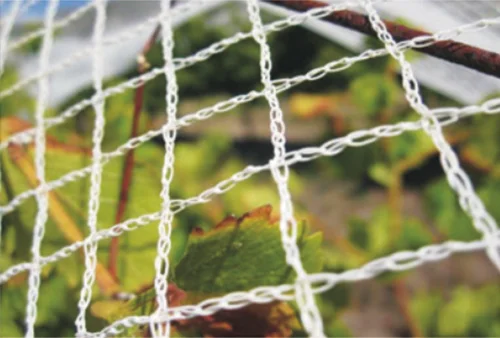In modern agricultural production, especially in viticulture, safeguarding crops from external biotic stressors such as birds is crucial to ensuring both yield quantity and quality. One of the most efficient and widely adopted methods to protect vineyards is through the use of bird netting. Among the various types of bird netting available, warp knitted vineyard bird netting has emerged as a superior solution due to its durability, flexibility, and cost-effectiveness. In this blog post, CANA, a high performance warp knitted protection netting manufacturer, will share the role of vineyard bird netting in agricultural production, including its structure, functionality, advantages, and impact on crop yields and sustainability.
Understanding Warp Knitted Netting: Structural and Functional Insights
Warp knitting is a type of fabric production in which the yarn zigzags along the length of the fabric, following a vertical or warp direction. This technique differs fundamentally from weft knitting, where the yarn runs horizontally. Warp knitted fabrics are generally constructed using synthetic materials such as high-density polyethylene (HDPE), polypropylene, or nylon, which are UV-stabilized to withstand prolonged exposure to sunlight.
The resulting netting structure is characterized by high tensile strength, uniform mesh size, and resistance to unraveling when cut. These properties make warp knitted nets particularly suitable for agricultural applications where large surface areas need to be covered, and where the material is subjected to environmental stress such as wind, rain, and solar radiation.
Primary Role: Protection Against Avian Crop Damage
The most immediate and tangible function of vineyard bird netting is to act as a physical barrier between the fruit and avian pests such as starlings, finches, and blackbirds. These birds can cause significant economic losses by pecking at grapes, leading to both direct fruit loss and indirect problems such as fungal infections at the damaged sites.
Warp knitted bird netting, with its precise mesh sizing - typically ranging from 5 to 20 mm - can effectively exclude birds without impeding air circulation or sunlight penetration. By deploying this netting during the ripening season, viticulturists can prevent damage during the critical phase of sugar accumulation, which directly impacts wine quality.
Durability and Longevity in the Field
One of the standout advantages of warp knitted netting over its counterparts (such as extruded or woven netting) lies in its mechanical robustness and long service life. The warp knitted structure is less prone to tearing and fraying, and thanks to the use of UV-stabilized synthetic polymers, the material can retain its integrity for multiple growing seasons.
This longevity translates into lower operational costs over time. While the initial investment in warp knitted netting may be higher, its reusability reduces the need for annual replacements. Additionally, warp knitted nets are more resilient under mechanical tension, allowing them to be tightly secured without deforming or sagging, which further enhances their protective function.
Application Techniques and Installation Flexibility
Warp knitted vineyard bird netting can be deployed in several configurations depending on the vineyard layout, trellis system, and pest pressure. Common methods include:
* Draped Netting: The netting is laid directly over the vine rows, covering both sides and sometimes the top. This method is quick to deploy and is commonly used for small to medium-sized operations.
* Side Netting: Particularly suited for VSP (Vertical Shoot Positioning) trellises, side netting is applied only to the sides of the vines, where fruit exposure is highest. This method conserves netting material and facilitates easier canopy management.
* Canopy or Overhead Netting: Suspended above the vines using support poles and cables, this method is more labor-intensive but provides full coverage and ease of access for machinery and workers beneath the canopy.
Warp knitted netting is highly adaptable to all these configurations due to its flexibility and manageable weight. It can be easily cut to custom lengths and is compatible with various fastening systems including clips, hooks, and ropes.

Environmental and Agronomic Considerations
The use of warp knitted bird netting aligns well with integrated pest management (IPM) and sustainable agriculture practices. Unlike chemical deterrents, which can have non-target effects and contribute to pesticide resistance, physical barriers provide a non-lethal, environmentally benign method of pest control. This is especially important in organic viticulture, where synthetic inputs are heavily restricted.
Furthermore, bird netting can indirectly enhance grape quality. By reducing damage to fruit clusters, the risk of secondary infections such as Botrytis cinerea (grey mold) is minimized. This helps maintain the microbial integrity of the vineyard and reduces the need for fungicidal treatments, which can impact fermentation processes in winemaking.
Another often overlooked benefit is the reduction in fruit dehydration. Birds not only consume grapes but often puncture them without eating the entire berry. These punctures lead to accelerated water loss and changes in sugar-acid balance. By preventing such damage, netting helps in maintaining consistent fruit physiology across the vineyard.
Economic Impacts and Return on Investment (ROI)
Although the upfront cost of warp knitted vineyard bird netting is relatively high compared to disposable or single-season options, the overall economic impact is favorable. Return on investment calculations typically consider:
* Reduction in fruit loss: Bird damage can account for 5–30% loss in yields in unprotected vineyards. Mitigating this can result in substantial revenue recovery.
* Extended product lifespan: With proper care, warp knitted netting can last 8–10 years, amortizing costs over multiple harvests.
* Decreased labor costs: Due to its ease of installation and retrieval, labor time is significantly lower than that required for alternative protection methods.
In regions where premium wine grapes are cultivated, even a small improvement in yield or quality can justify the cost of netting, particularly when the price per ton is high.
Innovations and Future Directions
Recent innovations in warp knitted netting include the incorporation of smart materials and reflective fibers. For instance, netting that reflects specific wavelengths of light can influence grape maturation rates and pest behavior. Additionally, manufacturers are exploring biodegradable polymer options to enhance sustainability while maintaining structural performance.
Moreover, automation in netting deployment - such as tractor-mounted applicators - is increasingly being adopted in large-scale vineyards. Warp knitted netting' s resistance to stretching and deformation makes it well-suited for such mechanical handling, allowing for more efficient vineyard management.
Conclusion
Warp knitted vineyard bird netting plays an indispensable role in contemporary viticultural practices. It combines durability, effectiveness, and environmental compatibility to offer a robust solution against bird-induced crop losses. By preserving fruit quality and enhancing yield predictability, it contributes significantly to the economic and agronomic viability of vineyard operations.
As the industry continues to push towards more sustainable and efficient farming systems, the strategic use of warp knitted netting will remain a critical component in integrated vineyard management. Its adaptability to different vineyard designs, its proven longevity, and its alignment with ecological practices underscore its value in modern agricultural production.
www.cananetting.com
CANA
